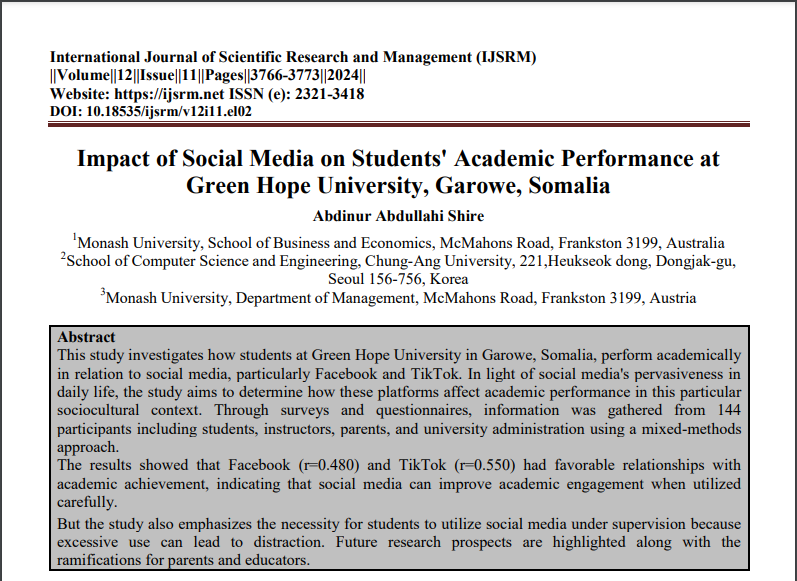Impact of Social Media on Students' Academic Performance at Green Hope University, Garowe, Somalia

Submission to VIJ 2024-11-14
Keywords
- Social media, TikTok, Facebook, academic performance, Green Hope University.
Copyright (c) 2024 Abdinur Abdullahi Shire

This work is licensed under a Creative Commons Attribution 4.0 International License.
Abstract
This study investigates how students at Green Hope University in Garowe, Somalia, perform academically in relation to social media, particularly Facebook and TikTok. In light of social media's pervasiveness in daily life, the study aims to determine how these platforms affect academic performance in this particular sociocultural context. Through surveys and questionnaires, information was gathered from 144 participants including students, instructors, parents, and university administration using a mixed-methods approach.
The results showed that Facebook (r=0.480) and TikTok (r=0.550) had favorable relationships with academic achievement, indicating that social media can improve academic engagement when utilized carefully.
But the study also emphasizes the necessity for students to utilize social media under supervision because excessive use can lead to distraction. Future research prospects are highlighted along with the ramifications for parents and educators.
References
- Kausar, S., & Ghafoor Awan, A. (2019). Impact of Using Social Media on Academic Performance of Students at Graduate Level: Evidence from Pakistan. Global Journal of Management, Social Sciences, and Humanities, 5(1), 116–142. www.gjmsweb.com.www.gjmsweb.com.
- Khan, L. K., Musani, K., & Dilshad, W. Bin. (2023). Impact of Use of Social Media on Academic Performance of Undergraduate Students in a Public Sector University. Priority-The International Business Review, 1(2), 32–42. https://theeyepublications.com/index.php/first/article/view/39
- Remedios C. Kulidtod, R., & Nahida S. Pasagui, N. (2017). Effects of Social Networking Media to the Academic Performance of the Students. 45(CoEMA), 59–64. https://doi.org/10.2991/coema-17.2017.11
- Ummah, M. S. (2019). No 主観的健康感を中心とした在宅高齢者における 健康関連指標に関する共分散構造分析Title. Sustainability (Switzerland), 11(1), 1–14. http://scioteca.caf.com/bitstream/handle/123456789/1091/RED2017-Eng-8ene.pdf?sequence=12&isAllowed=y%0Ahttp://dx.doi.org/10.1016/j.regsciurbeco.2008.06.005%0Ahttps://www.researchgate.net/publication/305320484_SISTEM_PEMBETUNGAN_TERPUSAT_STRATEGI_MELESTARI
- Ahmad, A. (2011, Feburary). Rising of Social Network Websites in India Overview. IJCSNS International Journal of Computer Science and Network Security, 11, 155-158.
- Das, D. B., & Sahoo, J. S. (2010). Social Networking Sites – A Critical Analysis of Its Impact on Personal and Social Life. International Journal of Business and Social Science.